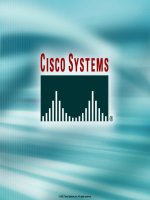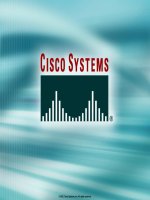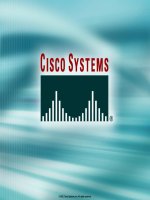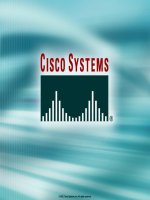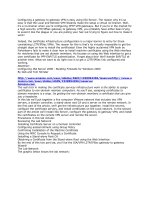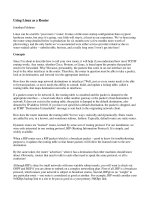CCNA - P4 - Configuring a Router
Bạn đang xem bản rút gọn của tài liệu. Xem và tải ngay bản đầy đủ của tài liệu tại đây (868.86 KB, 37 trang )
© 2002, Cisco Systems, Inc. All rights reserved.
© 2002, Cisco Systems, Inc. All rights reserved. ICND v2.0—1-2© 2002, Cisco Systems, Inc. All rights reserved. 2
Configuring a Router
© 2002, Cisco Systems, Inc. All rights reserved. ICND v2.0—1-3
Objectives
Upon completing this lesson, you will be
able to:
•
Use the CLI to interact with the Cisco IOS
software, given an operational router
•
Verify the default configuration of the device,
given a functioning router
•
Complete the initial device configuration, given
a functioning router
•
Configure IP addresses and IP subnet masks on
router interfaces, given a functioning router
© 2002, Cisco Systems, Inc. All rights reserved. ICND v2.0—1-4
Overview of Router Modes
© 2002, Cisco Systems, Inc. All rights reserved. ICND v2.0—1-5
Saving Configurations
wg_ro_c#
wg_ro_c#copy running-config startup-config
Destination filename [startup-config]?
Building configuration…
wg_ro_c#
wg_ro_c#
wg_ro_c#copy running-config startup-config
Destination filename [startup-config]?
Building configuration…
wg_ro_c#
•
Copies the current configuration to NVRAM
© 2002, Cisco Systems, Inc. All rights reserved. ICND v2.0—1-6
• Sets the local identity or message for the accessed router
or interface
Configuring Router Identification
© 2002, Cisco Systems, Inc. All rights reserved. ICND v2.0—1-7
Configuring a Router Password
© 2002, Cisco Systems, Inc. All rights reserved. ICND v2.0—1-8
Other Console-Line Commands
Router(config)#line console 0
Router(config-line)#exec-timeout 0 0
Router(config)#line console 0
Router(config-line)#logging synchronous
•
Prevents console session timeout
•
Redisplays interrupted console input
© 2002, Cisco Systems, Inc. All rights reserved. ICND v2.0—1-9
Router(config)#interface type number
Router(config-if)#
•
type includes serial, ethernet, token ring, fddi, hssi,
loopback, dialer, null, async, atm, bri, tunnel, and so on
•
number is used to identify individual interfaces
Router(config-if)#exit
•
Quits from current interface configuration mode
Router(config)#interface type slot/port
Router(config-if)#
•
For modular routers, selects an interface
Configuring an Interface
© 2002, Cisco Systems, Inc. All rights reserved. ICND v2.0—1-10
Enter Global
Configuration Mode
Router(config-if)#clock rate 64000
Router(config-if)#
Router(config)#interface serial 0
Router(config-if)#
Router#configure terminal
Router(config)#
Router(config-if)#bandwidth 64
Router(config-if)#exit
Router(config)#exit
Router#
Specify Interface
Set Clock Rate
(on DCE interfaces only)
Set Bandwidth
(recommended)
Configuring a Serial Interface
© 2002, Cisco Systems, Inc. All rights reserved. ICND v2.0—1-11
Router(config)#interface ethernet 2
Router(config-if)#media-type 10baset
Router(config)#interface ethernet 2
Router(config-if)#media-type 10baset
•
Selects the media-type connector for the
Ethernet interface
Ethernet media-type Command
© 2002, Cisco Systems, Inc. All rights reserved. ICND v2.0—1-12
Router#configure terminal
Router(config)#interface serial 0
Router(config-if)#no shutdown
%LINK-3-UPDOWN: Interface Seria0, changed state to up
%LINEPROTO-5-UPDOWN: Line Protocol on Interface Serial0, changed state to up
•
Enables an interface that is administratively shut down
Router#configure terminal
Router(config)#interface serial 0
Router(config-if)#shutdown
%LINK-5-CHANGED: Interface Serial0, changed state to administratively down
%LINEPROTO-5-UPDOWN: Line protocol on Interface Serial0, changed state to down
•
Administratively turns off an interface
Disabling or Enabling an Interface
© 2002, Cisco Systems, Inc. All rights reserved. ICND v2.0—1-13
•
Unique addressing allows communication
between end stations.
•
Path choice is based on destination address.
Location is represented by an address
Introducing IP Addresses
© 2002, Cisco Systems, Inc. All rights reserved. ICND v2.0—1-14
IP Addressing

